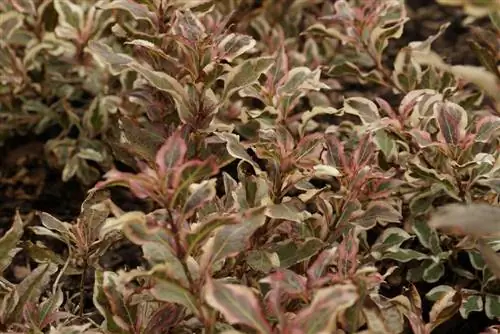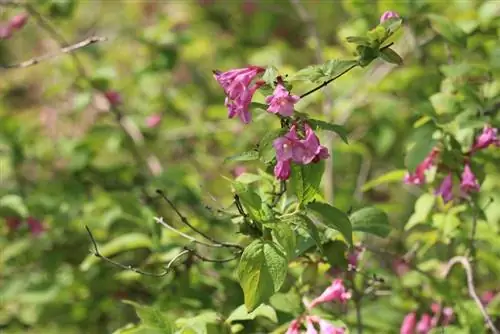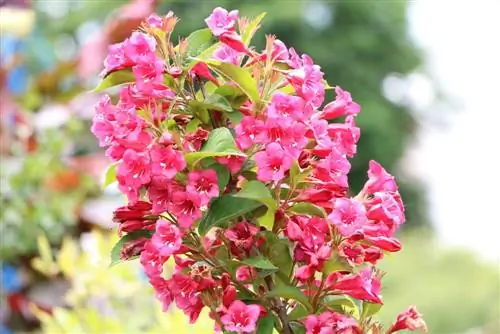- Author admin [email protected].
- Public 2023-12-17 03:39.
- Last modified 2025-06-01 06:48.
The weigela ennobles the bed and balcony in spring with its lavish flowers. If properly cared for, a colorful bloom rises above the bushy foliage in autumn, followed by a furious coloring of the leaves. This perfectly formed appearance on the garden stage makes the Asian flowering shrub a highly sought-after component in the creative design plan. Discover your personal favorite here from a selection of beautiful Weigelia varieties. The following instructions for care and propagation provide you with all the information about successful cultivation.
Recommended Weigelia varieties
Weigela is native to Japan, China and Korea, where it is widespread. Magnificent varieties have emerged for cultivation in our gardens, with individual attributes that are recommended for a wide variety of application scenarios. The following selection introduces you to premium varieties in more detail:
Bristol Ruby
The uncrowned queen of the variety family delights with carmine-red flowers that tower above the shapely foliage like sparkling rubies. The elliptical leaves are light green and delicately hairy on the underside, while the surface is smooth and rich green. When the wind plays with the leaves, subtle color effects occur all summer long. The highlight of this play of colors is a golden yellow to light brown autumn color, which, with a little luck, is preceded by a pretty bloom.
- Flowering time: May to June with re-blooming in autumn
- Growth height: 200 to 300 cm
- Annual growth: 30 to 50 cm
Nana Variegata - Variegated Weigela
This Weigelia variety combines delicate pink flowers with creamy-white edged, summer green leaves. Even their pink buds are a feast for the eyes in April. With its compact, bushy habit, Nana Variegata likes to decorate small gardens, show off in the front garden or on the balcony. The top-class breeding rightly owes its nickname “Lovely Weigela” to these unique attributes.
- Flowering time: May to June with re-blooming in autumn
- Growth height: 150 to 200 cm
- Annual growth: 10 to 20 cm
Purpurea - Red-leaved Weigelia

If you are looking for a flowering small shrub with red leaves, you are well advised to go with Purpurea. The dark pink bell-shaped flowers harmonize wonderfully with the brown-red foliage, which gradually turns green towards autumn. Against the dark backdrop of an evergreen confiture hedge or on the sunny balcony, this Weigelia variety shows off its most beautiful side.
- Flowering time: end of May to mid-June and re-blooming in autumn
- Growth height: 100 to 150 cm
- Annual growth: 15 to 25 cm
Gold Weigela - Yellow-flowered Weigela
The Weigelia family impressively demonstrates its variety of varieties with this hybrid. The golden yellow, trumpet-shaped flowers are decorated with orange spots on the inside. Hosts of butterflies, bees and bumblebees swarm around the floral beauty. Integrated into mixed flower hedges, the golden weigela with its dense foliage offers numerous birds, such as the bullfinch, a valuable nesting place. This premium variety says goodbye to the winter break with a subtle foliage color.
- Flowering time: In May/June and again in September/October
- Growth height: 120 to 150 cm
- Annual growth: 10 to 30 cm
All Summer Red - Dwarf Weigelia
If the Nana variegata variety is still too big for you, you will be happy to take note of this variety. The dwarf weigela displays its lush flowers in bright red. With this innovative hybrid, the breeders placed emphasis on a long-lasting flowering period and compact, tightly upright growth. Since 'All Summer Red' grows just as tall as it is wide, it is just as useful in troughs as it is as an attractive border for beds and graves. In the small front garden, it welcomes guests as a solitary plant with its vermilion-red flowers all summer long.
- Flowering period: From May to October continuously
- Growth height: 50 to 75 cm
- Annual growth: 10 to 20 cm
Care instructions
The weigela is highly valued as an ornamental shrub not least because of its frugal care requirements. Fortunately, the multifaceted varieties comply in this regard, so that the following instructions apply to all hybrids.
Location
By choosing the right location, you set the course for an opulent abundance of flowers. The sunnier the place in the bed and on the balcony, the denser the flower dress. The weigela also blooms in semi-shady locations, although a reduced number of flowers can be expected here. A place surrounded by air is an advantage, as the leaves dry more quickly after a rain shower and are therefore better protected from all kinds of fungal infections.
One of the most important location factors is sufficient space capacity. With an annual growth of up to 50 cm and a height of up to 300 cm, the weigela stakes out its territory with its expansive habit. A distance of 100 to 150 cm should therefore be maintained from the plant neighbors.
Soil and substrate
If fresh, moist, nutritious and well-drained soil is added to the sunny location, the weigela will happily extend its roots here. Since the shallow root system is equipped with a dense network of fine roots, the soil must neither be compacted nor waterlogged. A slightly acidic to alkaline pH value of 6.5 to 7.0 is ideal, as any good garden soil usually has.
So that compact small shrubs among the Weigelia varieties in the pot meet the high expectations, we recommend a good compost-based pot plant soil. The permeability is optimized by mixing in perlite, lava granules or fine quartz sand until a structurally stable consistency is created. A drainage made of pottery shards, which you place on the bottom of the pot above the water drain, serves as reliable protection against waterlogging.
Pouring
The rule of thumb for correct watering is: constant core moisture in the root ball with intermediate drying phases on the surface. This requirement is so easy to fulfill:
- Only water a weigela when the soil has dried out
- Press your finger lightly into the substrate to check the moisture content
- Pour rainwater or stale tap water directly onto the root disk
In the ideal location with fresh, moist soil, a weigela bush in the bed usually only needs additional water during dry summer days. In a sunny spot in the pot, however, the root ball dries out more quickly, so watering is more frequent.
Fertilize
The Weigela invests all of its strength in the lush flowers and the dense foliage. Nutrient-rich soil alone does not cover the high energy requirements for this floral masterpiece. With the following nutrient supply, used reserves are quickly replenished:
- Administer an organic or mineral-organic fertilizer in March/April
- Fertilize again after the repair cut in June/July
- Spread compost, horn shavings or fertilizer beads on the root disc
- Rake the fertilizer carefully and spray with water
We recommend adding liquid fertilizer in the bucket as it is easy to administer. From April to July, add the fertilizer to the water every 3 weeks.
Tip:
A year-round layer of mulch on the root disk effectively contributes to growth, flowering and winter hardiness. A 3 to 5 cm thick layer of leaves, which is renewed every 2 to 3 months, is best suited.
Cutting

Weigelias bloom on their old wood twice a year. This species-specific characteristic requires a moderate cutting approach so that buds that have already formed do not accidentally fall victim to the scissors. How to do it right:
- After the first bloom, cut off all withered flowers
- Make the cut in front of the nearest bud
- Clean out the bush again in autumn if seed formation is not desired
- Thinning out an older Weigelia bush in February/March
By cutting off the two oldest shoots close to the ground every two years from the fifth year onwards, in addition to thinning, the weigela experiences continuous rejuvenation. This prevents aging from the inside out and prevents radical pruning.
Tip:
Wound closure on trees is largely a thing of the past. Only on larger cut surfaces after winter pruning are the wound edges thinly coated with paste or clay to protect the cambium located there from frost and drought stress. Otherwise, modern home gardeners rely on the self-healing powers of their weigela, as competent forestry scientists recommend.
Wintering
In their Asian distribution areas, the ancestors of today's Weigelia varieties learned to deal with frost and snow and passed this ability on to their cultivars. Therefore, even a harsh Central European winter does not throw the ornamental shrubs off track. The following precautions are only recommended in the planting year and in pot culture:
- Protect freshly planted shrubs in autumn with a 20 to 30 cm high layer of leaves
- Cover the young shoots with a breathable and translucent fleece until February
- Place the bucket on wood before the onset of winter and wrap it with fleece
- Water every now and then so that the soil around the root ball doesn't dry out
Well-rooted, adult weigelias go through the winter he althy and happy in the bed without additional protective measures.
Propagation
So that the lavish sea of flowers of your most beautiful weigela decorates the garden in other locations, you can easily grow additional specimens using cuttings. The best time for propagation is in summer when the flowering trees are full of sap. This is how it works:
- Cut off half-woody, non-flowering head cuttings that are 15 to 20 cm long
- Cut off herbaceous shoot tips down to the half-woody area
- Pluck the leaves in the lower half and remove any buds
- Fill cultivation pots with emaciated potting soil, pricking substrate or a mix of peat and sand
- Insert one cutting so deep that only one or two pairs of leaves can be seen
- Press the substrate well and water
Until autumn, place the cuttings in a partially shaded, warm and protected place in the garden to water them regularly. Throughout the winter, care for the young plants in a bright window seat at temperatures between 10 and 15 degrees Celsius. If necessary, repot a rooted cutting if there is no more space in the growing container for the expanding root system. By the time the planting window opens in April/May, your pupils will have transformed into strong, young weigelias that can be planted out in a sunny location.
Diseases and pests

The weigela owes its reputation as an easy-care ornament for the garden and balcony to, among other things, its resistance to diseases. When cared for in the right location according to these instructions, pathogenic pathogens avoid the flowering bush.
The omnipresent aphids dare to attack even a lovingly cared for Weigelia. A visible sign of an infestation are curled and stunted leaves because the pests drain the plant sap there. Therefore, check the undersides of the leaves regularly because the lice like to hide here. In the early stages, you can get rid of the parasites with a proven home remedy. This is how it works:
- Heat 1 liter of rainwater in a kettle and dissolve 1 tablespoon of pure potash soap in it
- After cooling, add another 15 ml of spirit
- Pour the solution into a hand sprayer
- Spray the affected bush with the soap solution every 2 days
Commercial household soft soap is not suitable for this purpose as it contains thickeners, colorants and other chemical additives. The home remedy has proven itself so well in practice that specialist retailers now offer ready-made soap solutions for combating aphids.
Is weigela poisonous?
The weigela is perfect for beautifying the family garden. All parts of the plant are non-toxic, so proximity to children and pets poses no risk. The flower beauty also does without sharp thorns, which eliminates the risk of injury if it comes into contact with the skin. The leaves are of course inedible for humans and animals, so they should not be used as green food for rabbits, hamsters or guinea pigs.
Conclusion
The weigela is one of the few ornamental shrubs that bloom twice a year. This special property, coupled with modest requirements, makes the Asian flower beauty the perfect component for beds and balconies. If you are still looking for your personal favorite, our selection of varieties will provide you with an informative decision-making aid. With the practice-oriented care instructions you have all the important information at hand to professionally care for and successfully propagate Weigelia. Without any toxic ingredients or sharp thorns, the enchanting flowering shrub deserves a place of honor in every family garden.

